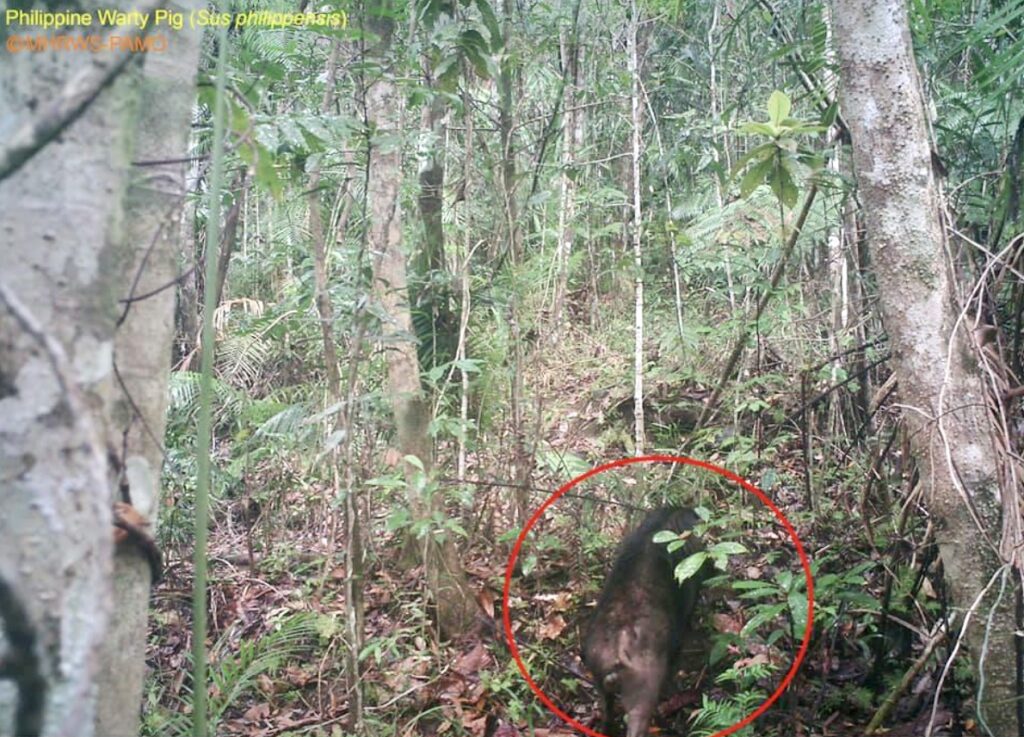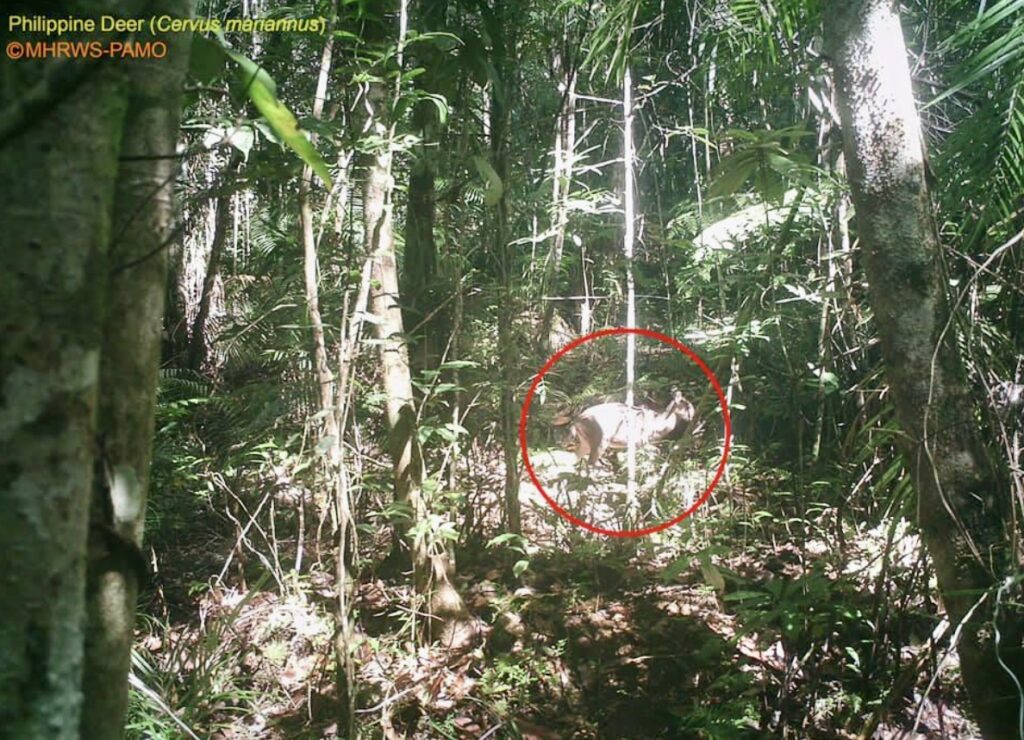Text by Henrylito D. Tacio
Photos courtesy of DENR
In December 2018, the Department of Environment and Natural Resources (DENR) conducted a 160-trapping day using the state-of-the-art camera traps installed in the buffer zone of Mount Hamiguitan Range Wildlife Sanctuary in Davao Oriental.
In a report released in April the following year, at least three of the country’s endemic animals were spotted in the area: three Philippine warty pigs (Sus philippensis), two Philippine deer (Cevus mariannus), and three Philippine macaques (Macaca fascicularis philippensis).
Both the Philippine warty pigs and Philippine deer are listed as “vulnerable” species, according to the DENR Administrative Order No. 2004-15’s establishment of List of Threatened Species and their categories pursuant to Republic Act 9147 or the Wildlife Act.
They are considered “vulnerable” as their population is already declining. The Philippine macaques, on the other hand, are on the list of Other Threatened Species, which means they are prone to extinction due to their small population.
“The presence and absence of these species indicate the status of our forest and other habitats,” said Clint Michael Cleofe, ecosystems management specialist 1 of Mount Hamiguitan Range Wildlife Sanctuary and Provincial Environment and Natural Resources Officer of Davao Oriental.
Mount Hamiguitan is a UNESCO (United Nations Economic, Scientific, and Cultural Organization) World Heritage Site and ASEAN (Association of Southeast Asian Nations) Heritage Park.
The mountain range – which has a protected forest area of approximately 2,000 hectares – “showcases terrestrial habitats at different elevations that provide critical habitats for the globally threatened and endemic flora and fauna species,” says the official website of the Province of Davao Oriental.
Davao Oriental is one of the “megadivese” yet “hotspot” focal areas in the country.
“The province contains a high proportion of unique biodiversity and at the same time, it has become a hotspot because its forest and other natural areas, with their unique plants and animals, are being lost at a fast rate,” observed Dr. Bernd-Markus Liss, principal advisor of the German Development Cooperation that funded a biodiversity conservation program in the province.
Biological diversity
Biodiversity – coined from biological diversity – is most often thought of as the variety of organisms on earth. Yet, it also includes two other factors: ecological diversity (the variety of ecosystems and ecological communities) and genetic diversity (the range of genetic differences found within and between species).
“All three aspects are crucial for the success and development of life on earth,” explains People and the Planet, a group raising environmental concerns based in London. “Since environmental conditions at every level are constantly changing, only diversity can ensure that some individuals and species will be able to adapt to the changes.”
Species declines and extinctions have always been a natural part of that process, but there is something disturbingly different about the current extinction patterns.

Philippine warty pig 
Philippine deer
“Like the dinosaurs 65 million years ago, humanity now finds itself in the midst of a mass extinction: a global evolutionary convulsion with few parallels in the entire history of life,” wrote John Tuxill and Chris Bright, authors of Losing Strand in the Web of Life. “But unlike the dinosaurs, we are not simply the contemporaries of a mass extinction – we are the reason for it.”
Unearthing new species
The Philippines is the world’s second-largest archipelago country after Indonesia. It comprises more than 7,100 islands covering 297,179 square kilometers in the westernmost Pacific Ocean.
The country, for instance, has 400 out of 500 coral species known in the world. “Every time we go in the water, someone discovers something that’s never been seen before,” said Dr. Terrence Gosliner, dean of science and research collections at the California Academy of Sciences who headed the 2011 Philippine Biodiversity Expedition.
Dr. Gosliner believed that the biodiversity in the Philippines remains relatively unknown. He’s not alone; many scientists think that many new species remain to be discovered in the country.
At the time when Ramon Paje was the environment secretary, about 270 wildlife species were discovered in the country within the last 25 years. “These endemic species are our living jewels. They are irreplaceable and unique components of our awesome environmental heritage,” he pointed out.
The Biodiversity Management Bureau (BMB), a line agency of DENR, has included in its list of new discoveries 29 new species of rodents found across the country; three species of bats from Mindoro and Abra; four bird species from Cagayan, Cebu, and Camiguin; and 44 reptile and 29 amphibian species from Luzon, Negros-Panay, Greater Mindanao and Sulu.
More than 160 plant species have also been discovered, including varieties of the world’s largest flower, Rafflesia. The Philippines ranks fifth in the world in terms of number of plant species and hosts about five percent of the world’s flora.
On the verge
“The Philippines, owing to its rich islands and water formations, has been home to some of the rarest and beautiful creatures for generations,” said Land Bank of the Philippines in its 2013 Calendar. “Over the years, a treasure trove of endemic animals and plants has been discovered by local and foreign scientists, clearly signifying our natural landscape as one of the world’s most formidable hotspots for biodiversity.”
The Convention for International Trade of Endangered Species (CITES), of which the Philippines is a signatory, has listed several wildlife species in the country that are rare, threatened, or endangered. Among these are the Philippine eagle (the country’s bird icon), tamaraw, calamian deer, Palawan bearcat, Mindanao gymure, Philippine tarsier, Panay flying fox, Cebu black shama, Philippine cockatoo, bungang ipot, tagbak, and Sander’s glocacia.
“A few decades ago, the wildlife of the Philippines was notable for its abundance; now, it is notable for its variety; if present trend of destruction continues, Philippine wildlife will be notable for its absence,” deplored Dr. Lee Talbot, a well-known ecologist, and geographer.
“The Philippines is one of the most threatened in the world. The rate of extinction of species is 1,000 times the natural rate because of man-made activities,” said then DENR Undersecretary Demetrio Ignacio. “It is a crisis. We are the hottest of the hot spots.”
Deforestation
The threats to the country’s once lush and diverse wildlife are many. But the primary culprit is the loss of its natural habitat, particularly the tropical rainforests. More than 30 years ago, about 10.9 million hectares of the land area were covered by forest, according to the DENR.
In 2003, the forest cover dwindled to about 7.11 million hectares. “Yearly, it is estimated that 100,000 hectares of Philippine forest are destroyed continuously, limiting its production capacity and weakening its environmental and socio-cultural functions,” the environment department deplored.
“Shifting cultivation, timber extraction, mining and continuing conversion of forest to other land uses are still experienced despite the government’s continued efforts to protect, conserve and rehabilitate the forest,” the DENR added.
The UN Food and Agriculture Organization reports that a pair of Philippine eagles needs at least 7,000 to 13,000 hectares of forests as a nesting territory.
“With the forest, the species cannot survive over the long term,” said Dennis Salvador, the executive director of the Philippine Eagle Foundation, Inc. “Without the forest, not only the Philippine eagle will go extinct, but so will the dreams and aspirations of millions of marginal income families who rely on the forest to survive.”
Protection
“Protection of biodiversity should be one of the top priorities of any meaningful strategy to safeguard the world’s biological heritage,” suggests John C. Ryan, author of Life Support: Conserving Biological Diversity.
As Dr. James Kirchner, an American professor of earth and planetary science at the University of California, puts it: “The planet would be biologically depleted for millions of years, with consequences extending not only beyond the lives of our children’s children, but beyond the likely lifespan of the entire human species.”
But there is still a glimmer of hope.
“Humans, after all, are not dinosaurs,” Tuxill and Bright write. “We can change. Even in the midst of the mass extinction, we still largely control our destiny, but only if we act now. The fate of untold numbers of species depends on it. And so does the fate of our children, in ways we can barely begin to conceive.”
Environmental laws
In the Philippines, several environmental laws that protect these natural heritages have been passed. Unfortunately, these laws are not reinforced due to internal conflicts over policy direction and jurisdiction as well as a general lack of technical knowledge and political will, surmised Atty. Jose A. Canivel, Executive Director of the Philippine Tropical Forest Conservation Foundation.
“Lawmakers, decision makers, policy makers have shown little interest in biodiversity conservation, because there is little knowledge, and with little knowledge there is very little value attached,” Canivel said.
But, “of all the global problems that confront us, (loss of biodiversity) is the one that is moving the most rapidly and the one that will have the most serious consequences,” deplored Dr. Peter Raven, director of Missouri Botanical Gardens in the United States.
Saving biodiversity
Saving biodiversity, however, is very expensive: an estimated $300 billion a year. But that’s worth it.
“Biodiversity is the basis of everything we do in agriculture, everything we do in health,” Brazilian Braulio Ferreira de Souza Dias, the chief of the U.N. Convention on Biological Diversity, told Reuters. “So the development of new vaccines, the development of new cultured varieties of plants is based on biodiversity, genetic resources.
“If we lose biodiversity,” he pointed out, “we lose the options for future development in these areas.”
The Philippines should heed that warning.
“Our country is remarkably rich in biodiversity, from coral reefs to forests, rivers and lakes. Conservation of these resources is most critical to species survival, stable ecosystems and economic development in the Philippines and the world as well,” said Professor Perry S. Ong, who was director of the University of the Philippines Institute of Biology at the time of death in 2019.
But “saving a species is more than a simple matter of putting it in a cage or pot,” Paje reminded. “It requires us to protect or rebuild its habitat, as well as the balance it keeps in relation to other species lower and higher in the food chain or web of life.”

